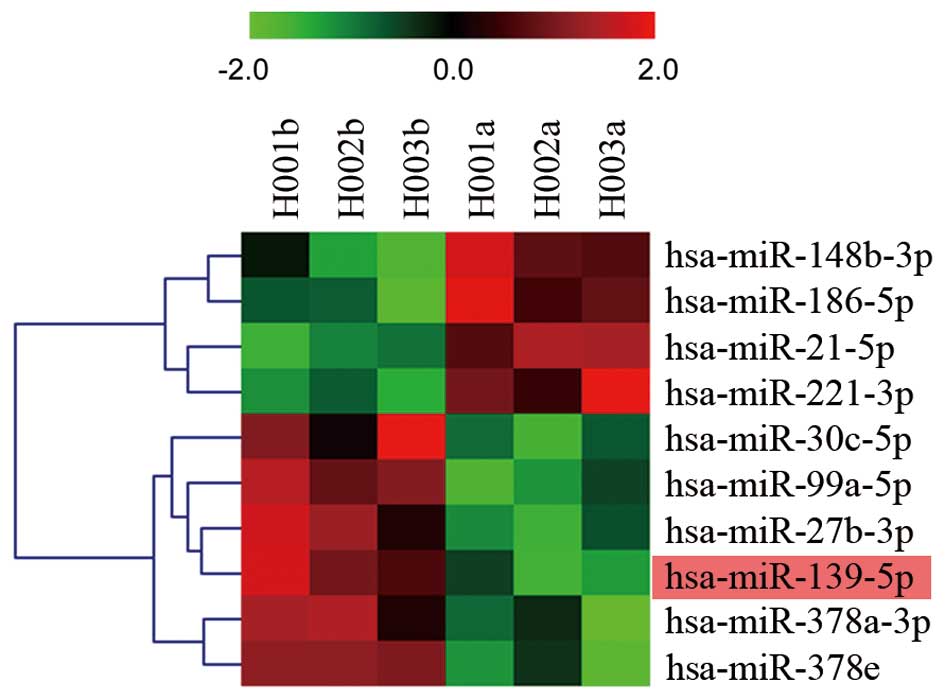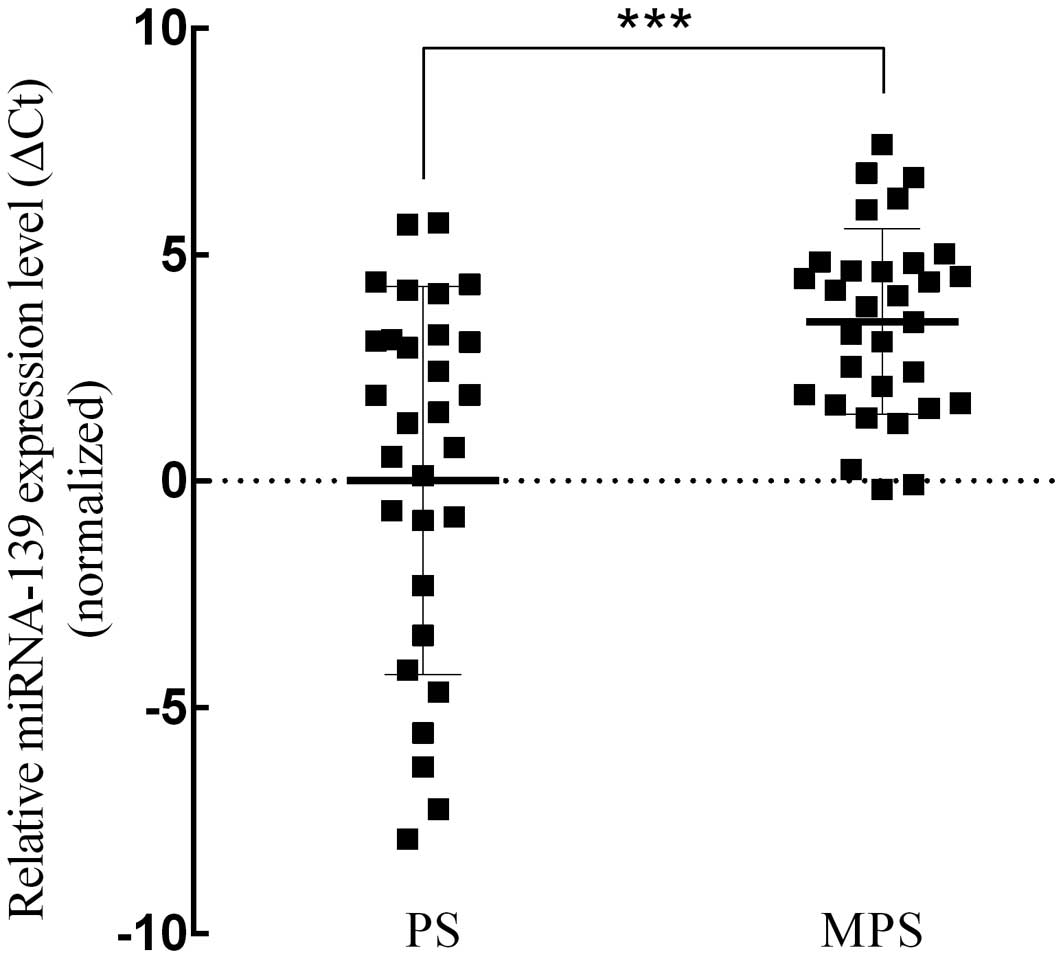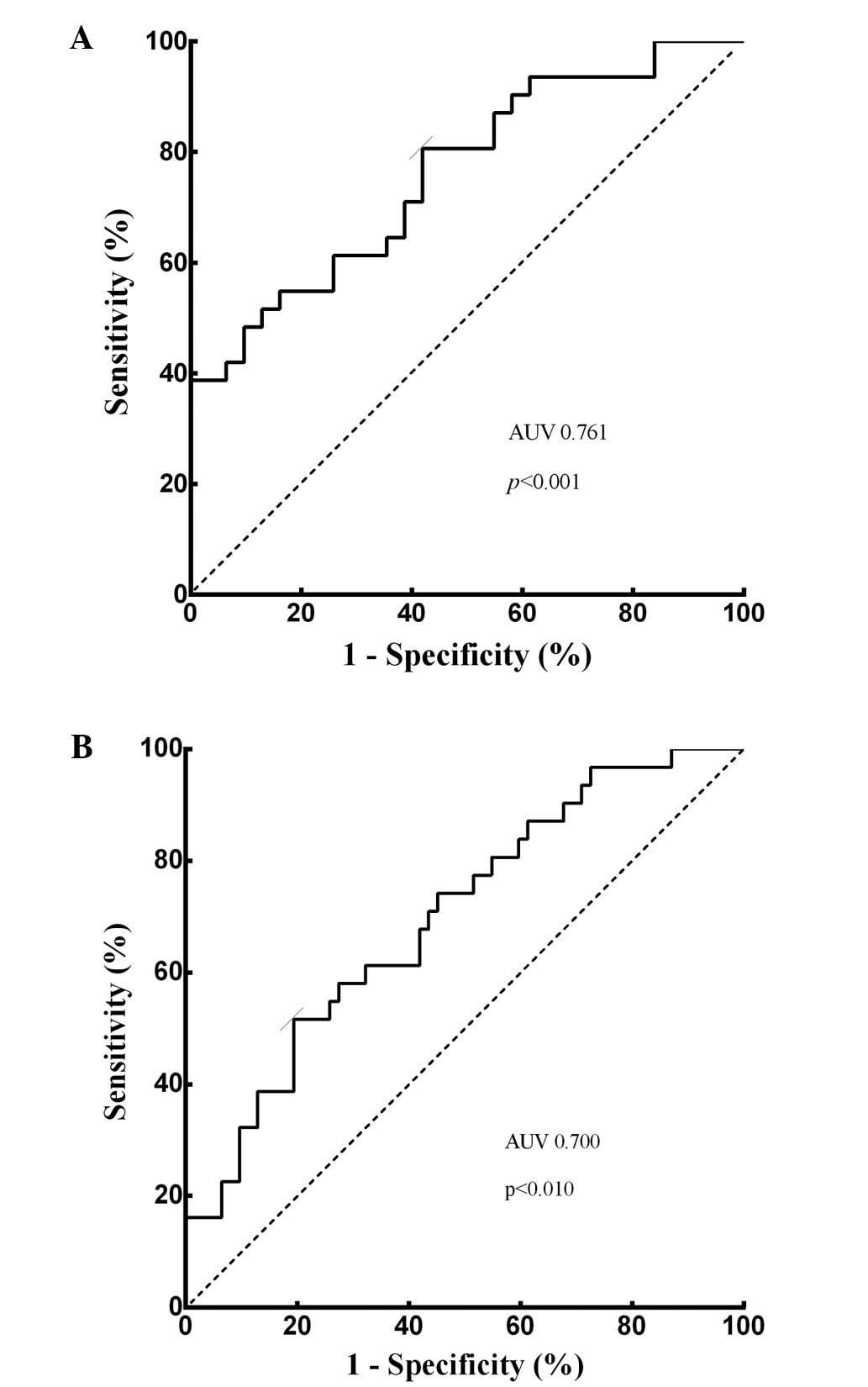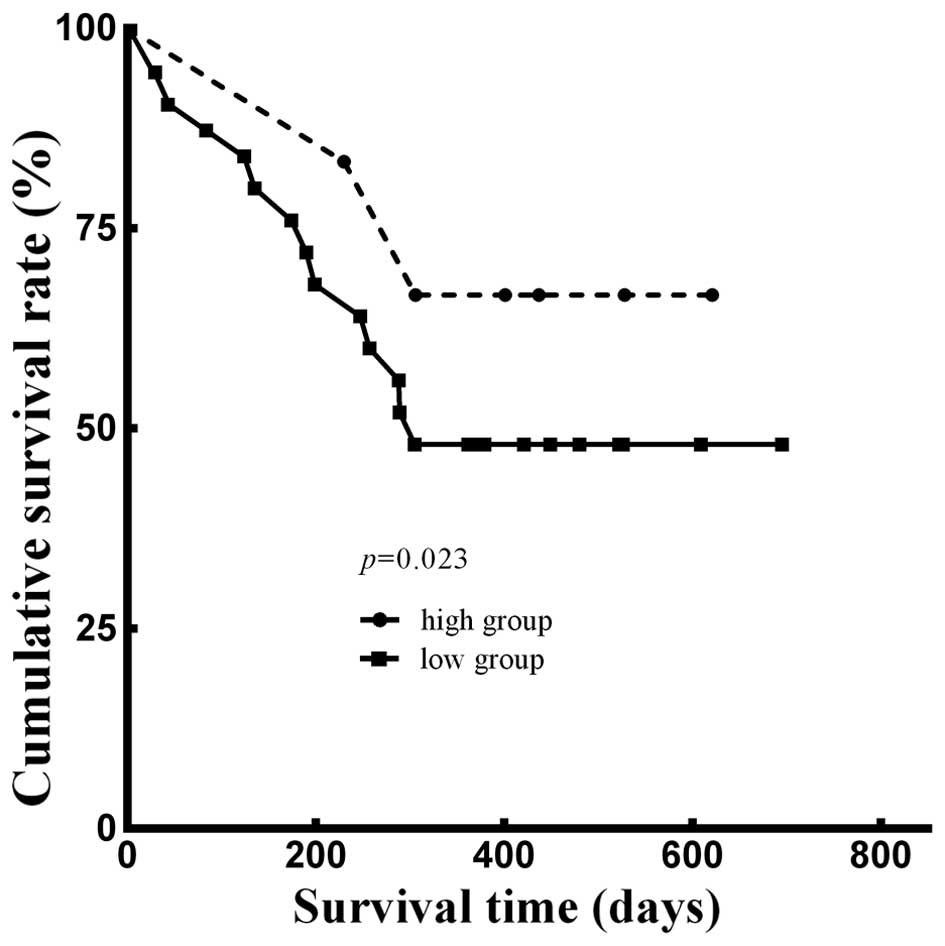Downregulation of microRNA-139 is associated with hepatocellular carcinoma risk and short-term survival
- Authors:
- Published online on: February 19, 2014 https://doi.org/10.3892/or.2014.3032
- Pages: 1699-1706
Abstract
Introduction
Hepatocellular carcinoma (HCC), the fifth in incidence among malignant tumors, accounts for 70–85% of primary liver cancer cases. Each year, 748,000 cases are newly diagnosed as HCC worldwide, and over half of them are in China (1), where HCC is the second most frequent cause for cancer-related mortality since the 1990s (2). HBV infection is the primary etiology that leads to liver cirrhosis-related carcinoma (3). The reason for the high mortality in HCC is that the tumor is always detected at advanced stages when curative therapy cannot be carried out due to intrahepatic or extrahepatic metastases. Although serum α-fetoprotein (AFP) has been widely accepted and used as a serous biomarker for screening HCC in a high risk population for years, the sensitivity and specificity of serum AFP only ranged from 40–65 and 76–96%, respectively (4), suggesting it may not be an ideal indicator to identify HCC from other diseases. Therefore, discovering new biomarkers for early diagnosis of HCC are still needed in clinical practice.
Mature microRNAs (miRNAs) are 19- to 25-nt transcripts of small non-coding RNA family processed from 70- to 100-nt hairpin-shaped precursors. The sequences of some miRNAs are conserved in various biological species, suggesting that these tiny molecules participate in essential processes of development, proliferation, differentiation and/or apoptosis in organisms (5). Depending on certain cellular functions of their targets, dysregulation of miRNAs may play oncogenic roles, such as Myc, or tumor suppressor roles, such as p53, to induce or inhibit tumorigenesis (6). Meanwhile, the importance of miRNAs in cancer progression has been reported, as miRNAs can both influence the effect of chemotherapy (7) as well as the development of drug resistance (8). Although the precise biological functions of miRNAs are not yet fully understood, some studies demonstrated that miRNA expression profile is distinguished in diverse diseases, indicating that miRNAs may be used as biomarkers for cancer diagnosis and prognosis prediction (9,10). Whether those dysregulated miRNAs are related to HCC and/or as a general mechanism in disease progression to cancer is an important concern for utilization of miRNAs as biomarkers for HCC risk, treatment response and clinical outcome prediction (11).
In the present study, we investigated comprehensive miRNA expression profiling of HCC using miRNA microarray in hepatocellular cancerous tissue and peritumoral non-cancerous tissue, and found that microRNA-139 (miRNA-139) was significantly downregulated in hepatocellular cancerous tissue. Furthermore, we detected and verified the miRNA-139 expression level in tissue and blood to investigate the correlation between miRNA-139 and clinical characteristics to identify the diagnostic and prognostic values of miRNA-139 in HCC patients.
Materials and methods
Patients, samples and data collection
The study population was enrolled at the general surgery department of Tangdu Hospital affiliated to the Fourth Military Medical University (Xi’an, China). Among the study population, 31 patients were newly diagnosed and histologically confirmed HCC, and subsequently received curative hepatectomy according to the National Comprehensive Cancer Network (NCCN) guidelines for hepatobiliary cancer. Cancerous tissue samples (CT group) were collected from surgery and pathologically confirmed as HCC; peritumoral non-cancerous tissue samples (NT group) were collected from normal liver tissue at 3 cm beyond the tumor margin. Plasma samples (PS group) were obtained from patients prior to surgery, while the matched plasma samples (MPS group) were obtained from 31 age- and gender-matched chronic HBV-hepatitis (CH) patients. The clinical characteristics of all subjects are summarized in Table I. All study subjects provided informed consent, and the present study was approved by the Review Board of Tangdu Hospital Ethics Committee.
Table IClinicopathological characteristics of hepatocellular carcinoma (HCC) patients and chronic HBV-hepatitis (CH) patients. |
miRNA microarray
miRNA microarray was performed in three pairs of tissue specimens which were collected from two male and one female HCC patients, using a service provider (LC Sciences, USA). The assay started from 4 to 8 μg total RNA sample and was 3′-extended with a poly(A) tail using poly(A) polymerase. An oligonucleotide tag was then liquated to the poly(A) tail for later fluorescent dye staining. Hybridization was performed overnight on a μParaflo microfluidic chip using a micro-circulation pump (Atactic Technologies, USA). On the microfluidic chip, each detection probe consisted of a chemically modified nucleotide coding segment complementary to target miRNA or control RNA and a spacer segment of polyethylene glycol to extend the coding segment away from the substrate. The detection probes were made by in situ synthesis using photogenerated reagent chemistry. Hybridization used 100 l 6X SSPE buffer containing 25% formamide at 34°C. After RNA hybridization, tag-conjugating Cy3 dye was circulated through the microfluidic chip for dye staining. Fluorescence images were collected using a laser scanner (GenePix 4000B; Molecular Devices, USA) and digitized using Array-Pro image analysis software (Media Cybernetics, USA). Data were analyzed by first subtracting the background and then normalizing the signals using a LOWESS filter (locally-weighted regression).
Total RNA extraction and quantification
All tissue samples were quick-frozen in liquid nitrogen and stored at −80°C immediately after removal. The isolation of tissue total RNA was completed using miRNeasy Mini kit (Qiagen, Germany). While extracting RNA, 25 mg frozen tissue with liquid nitrogen was ground to fine powder manually by mortar and pestle. After transferring the fine powder into an Eppendorf tube instantly, 700 μl QIAzol lysis reagent and 140 μl chloroform was added into the tube. The mixture was centrifuged at 12,000 rpm (revolutions/min) for 15 min at 4°C, and the aqueous phase, together with 1.5 volumes of 100% ethanol, was pipeted into a fresh tube. Then, the sample was purified in RNeasy Mini column using 700 μl buffer RWT once and 500 μl buffer RPE twice. Finally, 50 μl RNase-free ddH2O was used to elute total RNA from the RNeasy Mini column.
The plasma samples were isolated from whole blood before storing. In order to completely remove cell debris, the fresh whole blood was centrifuged at 1,600 rpm for 5 min, followed by 13,000 rpm for another 15 min. The plasma was stored in a cryogenic tube at −80°C. The miRNeasy Serum/Plasma kit provided by Qiagen was used to carry out extraction of total RNA from plasma according to the manufacturer’s instructions. The purity and concentration of total RNA preparations were determined by measuring the absorbance at UV 260 nm (A260) and UV 280 nm (A280) in a spectrophotometer (BioTek Epoch, USA). Pure RNA solution has an A260/A280 ratio of 1.9–2.1. All RNA preparations were stored at −80°C.
Reverse transcription and quantitative polymerase chain reaction (RT-qPCR)
Quantification of mature miRNAs was accomplished by a two-step method. Firstly, RNA was 3′-extended with a poly(A) tail using poly(A) polymerase, then the poly(A) product was reverse transcribed using oligo(dT)-Universal Tag (Tiangen, China). Subsequently, real-time quantitative PCR was performed with miRNA-139 primer and internal normalization primer according to the procedures of miRcute miRNA SYBR-Green qPCR detection kit (Tiangen) in Mx3000p sequence detection system (Agilent, USA), using the following conditions: 94°C for a 2-min cycle, followed by 45 cycles of 94°C for 20 sec, and 60°C for 34 sec. Briefly, 20 μl PCR system contained 2 μl of RT product solution, 10 μl of 2X miRcute miRNA Premix (including SYBR), 0.4 μl forward primer, 0.4 μl reverse primer and 7.2 μl RNase-free ddH2O. Triplicate PCRs were carried out for every cDNA sample, including negative controls without templates. hsa-miR-U6 and hsa-miR-16 were used as the internal normalization control for tissue and plasma sample respectively. All primers were designed and provided by Tiangen. The expression level of miRNA was computed using the comparative ΔCt method as previously reported (12).
Statistical analysis
Data analysis was performed by software SPSS 21.0 for Windows (IBM SPSS, USA). The difference of miRNA expression levels between groups was calculated using the t-test or Mann-Whitney U test. The Pearson’s correlation coefficient was used to calculate correlations. The diagnostic value for differentiating HCC patients from chronic HBV-hepatitis patients was evaluated by receiver operator characteristic curve (ROC curve) and the areas under ROC curve (AUC). The clinicopathological data were represented as means ± SD or frequencies, and differences between groups were calculated by the t-test, Mann-Whitney U test or Fisher’s exact test. The Kaplan-Meier method was applied to determine 1-year survival rate, and the statistical difference between two groups was analyzed using Cox’s proportional hazard model. A value of p<0.050 was considered to indicate statistically significant differences.
Results
Patient characteristics
There were 31 HCC patients (26 males and 5 females) with a mean age of 49 years (SD, 11; range, 27–69 years) while another 31 age- and gender-matched CH patients with a mean age of 49 years (SD, 10; range, 27–69 years) were enrolled in the present study. There was no significant difference in terms of demographic characteristics (age and gender), ALT (p=0.996), AST (p=0.115), TB (p=0.458), CEA (p=0.311), CA19-9 (p=0.749), and Child-Pugh grading (p=0.086). There was a significant difference in serum AFP value (p=0.007) between the two groups (Table I). Despite the difference in AFP value, the two groups were completely comparable in the present study. All HCC patients received curative hepatectomy during 2010–2012 with a median survival time of 362 days (± 160 days).
Association between miRNA-139 and HCC risk
Ten miRNAs dysregulated in HCC
We hypothesized that miRNAs may participate in liver tumorigenesis, and are aberrantly expressed in HCC samples. The miRNA microarray was performed in 3 hepatocellular cancerous tissues and corresponding paired non-cancerous tissues. Fig. 1 shows the heat map of these dysregulated targets and defined comprehensive miRNA expression profiling. The most conspicuous underexpression values were found for miRNA-139, miRNA-99a, miRNA-27b, miRNA-378a, miRNA-378e and miRNA-30c, while the overexpression values were found for miRNA-21, miRNA-221, miRNA-148b and miRNA-186.
miRNA-139 is downregulated in HCC tissue and plasma samples
Among these dysregulated miRNAs, miRNA-139 expression level was further analyzed in the CT and NT group by RT-qPCR to confirm the dysregulation in tumoral tissues. We found that miRNA-139 expression level was significantly lower in the patients of the CT group, compared to those in the NT group, with an average ΔCt value of −6.704 vs. −3.490 (p<0.001, t=−6.785; Fig. 2). Subsequently, we analyzed miRNA-139 expression level in the PS and MPS groups. The results demonstrated that miRNA-139 expression level in the PS group was significantly lower than that in the MPS group (average ΔCt value: 0.009 vs. 3.516, p<0.001, t=−4.117; Fig. 3). Meanwhile, the expression quantity of miRNA-139 in plasma was positively correlated to that in cancerous tissues (p=0.021, r=0.412; Fig. 4).
The diagnostic value of miRNA-139, AFP, and combination of miRNA-139 and AFP for HCC
ROC curve was performed. To evaluate the differentiating power of miRNA-139, plasma miRNA-139 expression level was confirmed to be weakly correlated with serum AFP value (p=0.024, r=0.406). Plasma miRNA-139 was able to identify HCC patients from CH patients with AUC value of 0.761 (95% CI, 0.643–0.878, p<0.001; Fig. 5A). At the cut-off value of −3.240 for plasma miRNA-139, the optimal sensitivity and specificity were 80.6 and 58.1%, respectively. Subsequently, with the cut-off value of 17.05 ng/ml, the AUC of serum AFP was 0.700 (p<0.010, 95% CI, 0.571–0.829; Fig. 5B), while the sensitivity and specificity were 51.6 and 79.3%, respectively, which was consistent with previous studies (13). Similarly, the differentiating power for combination of plasma miRNA-139 with serum AFP was analyzed, and we found that the combination of these two markers improved the power of screening HCC. The combination retrieved a significantly higher sensitivity of 90.3 and specificity of 87.1%, while the AUC increased to 0.770 (p<0.010, 95% CI, 0.654–0.886).
Plasma miRNA-139 correlates with clinicopathological features and 1-year survival analysis of HCC
We examined the correlations between plasma miRNA-139 expression level and some clinical features (Table II). All HCC patients were divided into two groups according to the expression status of miRNA-139: the low expression group (n=25), representing the patients with plasma miRNA-139 level under the optimal cut-off of −3.240, and the high expression group, representing the remaining 6 patients. The results revealed that plasma miRNA-139 expression level was correlated with Edmondson-Steiner grading (p=0.038), serum AFP value (p=0.043), CEA value (p=0.034) and DB value (p=0.041). However, there was no correlation between miRNA-139 expression level and other features, such as age, gender and clinical staging. Furthermore, we analyzed the 1-year survival rate using the Kaplan-Meier method. Adjusted for age, gender, weight loss percentage, smoking status (14), Edmondson-Steiner grading (15), Child-Pugh grading (16) and CLIP scoring (17), there was a significant difference between the two groups (p=0.023; Fig. 6). The Kaplan-Meier analysis indicated that the 1-year cumulative survival rate of patients in the high expression group was 66.7% with 503 survival days (± 69 days) median survival time, while that in the low expression group was 48.0%, and the median survival time was 439 days (± 50 days).
Table IIClinicopathological characteristics of HCC patients categorized according to the plasma miRNA-139 expression level. |
Discussion
Comprehensive out-of-hospital surveillance for chronic HBV-hepatitis patients has led to an earlier diagnosis of small lesions being precursors to malignancy (18). However, current existing tumor markers are insufficient to diagnose HCC at early onset. As a result, HCC is always defined as one of the most common and aggressive malignancies and usually with a poor prognosis worldwide. Although, liver transplantations are considered possible curative therapies, the strict Milan criteria and the limitations of donor availability impede patients from receiving liver transplantations (19). In addition, surgical resection is feasible only if the patient was evaluated with adequate functional liver remnant and solitary mass without major vascular invasion (20). To cure HCC patients at the relatively early stage, serum AFP value has been mostly applied for screening HCC, whereas the sensitivity and specificity are not satisfied.
Previous results revealed that miRNAs in blood circulation were markedly stable (21) and they may be potential diagnostic and prognostic factors in diverse diseases, particularly in the field of malignant neoplasms. Since the serum miRNA-21 was identified as the first one for diagnosing patients with diffuse large B cell lymphoma, and was associated with recurrence-free survival (22), circulating miRNAs were frequently studied as potential biomarkers for several types of cancer. To date, some miRNAs have been reported to be associated with the diagnosis and prognosis of liver cancer (23).
In the present study, we found that miRNA-139 expression was significantly lower in hepatocellular cancerous tissues than in their peritumoral non-cancerous tissues in miRNA microarray analysis. Then, the miRNA-139 expression profile was further detected in the tissue and plasma samples of 31 HCC patients and another 31 age- and gender-matched CH patients. Our results demonstrated that the average value of miRNA-139 expression level in HCC patients was 0.009, which was significantly lower than the value of 3.516 in CH patients. To our knowledge, the present study is the first one to identify miRNA-139 expression profiles both in HCC patients and CH patients. Low miRNA-139 level has been reported in digestive malignant tumor, such as gastric (24) and colorectal cancer (25), and also in adrenocortical carcinomas (26), parathyroid cancer (27), and squamous cell carcinoma in tongue (28). Thus, we consider that the downregulation of plasma miRNA-139 expression may be a common event in malignancies. In terms of liver cancer, Wong et al (29) first reported low-expression of miRNA-139 in HCC may suppress metastasis and progression of cancer cells by downregulating Rho-kinase 2. The following year, Professor Wong’s study team indicated that miRNA-139 is a tumor-suppressor miRNA, and enhancer of zeste homolog 2 (EZH2) may be responsible for the downregulation of the miRNAs in human HCCs (30). Based on the aforementioned findings, we further hypothesized that miRNA-139 may be excreted into the extracellular space and it may also be observed in blood. In the present study, we confirmed the correlation between miRNA-139 expression in plasma and cancerous tissue. Many studies have revealed the correlation between plasma miRNAs and cancerous tissue miRNAs, and have proposed the viewpoint that tissue intracellular miRNAs would be released into circulation during tumorigenesis, which was accompanied by pathological injury or cellular destruction (21,22). However, due to the sample size and the inconsistent data of certain patients in correlation analysis, the correlation coefficient of miRNA-139 expression in plasma and cancerous tissue was only 0.412. Further verification of our findings is required in a large population.
ROC curves for the diagnostic value of plasma miRNA-139 yielded an AUC of 0.761 with the sensitivity of 80.6% and the specificity of 58.1% in HCC diagnosis. Meanwhile, in the same population, AUC of serum AFP was 0.700 at the cut-off value of 17.05 ng/ml, with the sensitivity of 51.6 and the specificity of 79.3%. However, the combination of miRNA-139 and AFP increased the sensitivity to 90.3 and the specificity to 87.1%, while the AUC was 0.770, which was considerably better than miRNA-139 or AFP alone.
For a better understanding of the clinical implications of plasma miRNA-139, we also examined the correlations between plasma miRNA-139 expression level and clinical features. Edmondson-Steiner grading, which classifies HCC according to HCC cell differentiation, morphology, and mitotic phase (15), was negatively associated with plasma miRNA-139 expression. The plasma miRNA-139 expression level decreased with the increase of Edmondson-Steiner grading. Edmondson-Steiner grade was always considered to be positively correlated with the invasion and tumor recurrence may account for the dismal prognosis of patients with poorly differentiated HCC (31), indicating that miRNA-139 acted as the protective agent for HCC from differentiation. However, no association was found between miRNA-139 and clinical staging or scoring system (including TNM staging, Okuda scoring, BCLC staging, and CLIP scoring). Furthermore, the 1-year survival analysis showed the HCC patients with lower miRNA-139 expression presented shorter survival time, indicating miRNA-139 may be a potential indicator of survival prediction for HCC patients.
In conclusion, miRNA-139 is downregulated in both cancerous tissue and plasma of HCC. The plasma miRNA-139 is a possible diagnostic biomarker for identifying HCC patients while combined with other biomarkers, it is also a prognostic factor for indicating patient survival. However, the mechanisms of miRNA-139 dysregulation due to primary expression or secondary changes, require further investigation.
Acknowledgements
This study was supported by grant nos. 81172287 and 30901457 from the National Natural Science Foundation of China.
References
|
Jemal A, Bray F, Center MM, Ferlay J, Ward E and Forman D: Global cancer statistics. CA Cancer J Clin. 61:69–90. 2011. View Article : Google Scholar | |
|
Srivatanakul P, Sriplung H and Deerasamee S: Epidemiology of liver cancer: an overview. Asian Pac J Cancer Prev. 5:118–125. 2004. | |
|
Thorgeirsson SS and Grisham JW: Molecular pathogenesis of human hepatocellular carcinoma. Nat Genet. 31:339–346. 2002. View Article : Google Scholar : PubMed/NCBI | |
|
Marrero JA and Lok AS: Newer markers for hepatocellular carcinoma. Gastroenterology. 127(Suppl 1): S113–S119. 2004. View Article : Google Scholar : PubMed/NCBI | |
|
Jannot G and Simard MJ: Tumour-related microRNAs functions in Caenorhabditis elegans. Oncogene. 25:6197–6201. 2006. View Article : Google Scholar : PubMed/NCBI | |
|
Lujambio A and Lowe SW: The microcosmos of cancer. Nature. 482:347–355. 2012. View Article : Google Scholar : PubMed/NCBI | |
|
Meng F, Henson R, Lang M, et al: Involvement of human micro-RNA in growth and response to chemotherapy in human cholangiocarcinoma cell lines. Gastroenterology. 130:2113–2129. 2006. View Article : Google Scholar : PubMed/NCBI | |
|
Xia L, Zhang D, Du R, et al: miR-15b and miR-16 modulate multidrug resistance by targeting BCL2 in human gastric cancer cells. Int J Cancer. 123:372–379. 2008. View Article : Google Scholar : PubMed/NCBI | |
|
Budhu A, Jia HL, Forgues M, et al: Identification of metastasis-related microRNAs in hepatocellular carcinoma. Hepatology. 47:897–907. 2008. View Article : Google Scholar : PubMed/NCBI | |
|
Calin GA, Ferracin M, Cimmino A, et al: A MicroRNA signature associated with prognosis and progression in chronic lymphocytic leukemia. N Engl J Med. 353:1793–1801. 2005. View Article : Google Scholar : PubMed/NCBI | |
|
Luo X, Burwinkel B, Tao S and Brenner H: MicroRNA signatures: novel biomarker for colorectal cancer? Cancer Epidemiol Biomarkers Prev. 20:1272–1286. 2011. View Article : Google Scholar : PubMed/NCBI | |
|
Schmittgen TD and Livak KJ: Analyzing real-time PCR data by the comparative CT method. Nat Protoc. 3:1101–1108. 2008. View Article : Google Scholar : PubMed/NCBI | |
|
Marrero JA, Feng Z, Wang Y, et al: α-fetoprotein, des-γ carboxyprothrombin, and lectin-bound α-fetoprotein in early hepatocellular carcinoma. Gastroenterology. 137:110–118. 2009. | |
|
Shih WL, Chang HC, Liaw YF, et al: Influences of tobacco and alcohol use on hepatocellular carcinoma survival. Int J Cancer. 131:2612–2621. 2012. View Article : Google Scholar : PubMed/NCBI | |
|
Edmondson HA and Steiner PE: Primary carcinoma of the liver: a study of 100 cases among 48,900 necropsies. Cancer. 7:462–503. 1954. View Article : Google Scholar : PubMed/NCBI | |
|
Child CG and Turcotte JG: Surgery and portal hypertension. Major Probl Clin Surg. 1:1–85. 1964. | |
|
No authors listed. A new prognostic system for hepatocellular carcinoma: a retrospective study of 435 patients: the Cancer of the Liver Italian Program (CLIP) investigators. Hepatology. 28:751–755. 1998. View Article : Google Scholar : PubMed/NCBI | |
|
Sherman M: Approaches to the diagnosis of hepatocellular carcinoma. Curr Gastroenterol Rep. 7:11–18. 2005. View Article : Google Scholar | |
|
Forner A, Llovet JM and Bruix J: Hepatocellular carcinoma. Lancet. 379:1245–1255. 2012. View Article : Google Scholar | |
|
Maluccio M and Covey A: Recent progress in understanding, diagnosing, and treating hepatocellular carcinoma. CA Cancer J Clin. 62:394–399. 2012. View Article : Google Scholar : PubMed/NCBI | |
|
Mitchell PS, Parkin RK, Kroh EM, et al: Circulating microRNAs as stable blood-based markers for cancer detection. Proc Natl Acad Sci USA. 105:10513–10518. 2008. View Article : Google Scholar : PubMed/NCBI | |
|
Lawrie CH, Gal S, Dunlop HM, et al: Detection of elevated levels of tumour-associated microRNAs in serum of patients with diffuse large B-cell lymphoma. Br J Haematol. 141:672–675. 2008. View Article : Google Scholar : PubMed/NCBI | |
|
Tomimaru Y, Eguchi H, Nagano H, et al: Circulating microRNA-21 as a novel biomarker for hepatocellular carcinoma. J Hepatol. 56:167–175. 2012. View Article : Google Scholar : PubMed/NCBI | |
|
Bao W, Fu HJ, Xie QS, et al: HER2 interacts with CD44 to up-regulate CXCR4 via epigenetic silencing of microRNA-139 in gastric cancer cells. Gastroenterology. 141:2076–2087. 2011. View Article : Google Scholar : PubMed/NCBI | |
|
Shen K, Liang Q, Xu K, et al: MiR-139 inhibits invasion and metastasis of colorectal cancer by targeting the type I insulin-like growth factor receptor. Biochem Pharmacol. 84:320–330. 2012. View Article : Google Scholar : PubMed/NCBI | |
|
Schmitz KJ, Helwig J, Bertram S, et al: Differential expression of microRNA-675, microRNA-139–3p and microRNA-335 in benign and malignant adrenocortical tumours. J Clin Pathol. 64:529–535. 2011.PubMed/NCBI | |
|
Corbetta S, Vaira V, Guarnieri V, et al: Differential expression of microRNAs in human parathyroid carcinomas compared with normal parathyroid tissue. Endocr Relat Cancer. 17:135–146. 2010. View Article : Google Scholar : PubMed/NCBI | |
|
Wong TS, Liu XB, Wong BY, Ng RW, Yuen AP and Wei WI: Mature miR-184 as potential oncogenic microRNA of squamous cell carcinoma of tongue. Clin Cancer Res. 14:2588–2592. 2008. View Article : Google Scholar : PubMed/NCBI | |
|
Wong CC, Wong CM, Tung EK, et al: The microRNA miR-139 suppresses metastasis and progression of hepatocellular carcinoma by down-regulating Rho-kinase 2. Gastroenterology. 140:322–331. 2011. View Article : Google Scholar : PubMed/NCBI | |
|
Au SL, Wong CC, Lee JM, et al: Enhancer of zeste homolog 2 epigenetically silences multiple tumor suppressor microRNAs to promote liver cancer metastasis. Hepatology. 56:622–631. 2012. View Article : Google Scholar : PubMed/NCBI | |
|
Ker CG, Chen HY, Chen KS, et al: Clinical significance of cell differentiation in hepatocellular carcinoma. Hepatogastroenterology. 50:475–479. 2003.PubMed/NCBI |















